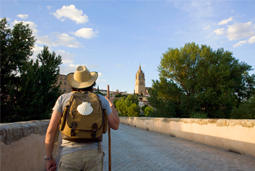
A stage with many changes in store. And the travellers should be ready for them. The landscape undergoes some drastic changes and the close vicinity of Salmantica, the former Roman road, will affect the whole route. Also the close vicinity to the Tormes River and the El Zurguén stream. Both are responsible for the soils that are once more much more fertile than the ones encountered up to this point. Likewise, they are the reason behind the reappearance, for the first time in quite a few kilometres, of land used to grow cereal crops. And so the way of life of the local inhabitants also changes, namely from rearing livestock to harvesting crops. Thus the significance of water.
Travellers will in quick succession pass by La Regañada plains, the hamlet of Santo Tomé de Rozados, in the municipality of Mozarbez, which is crossed, North-South by the Pilgrim’s Way and Aldegallega. The state highway, also known as the Ruta de la Plata, which for many years now has been a very modern motorway, runs several kilometres to the east, past Miranda de Azán. But we are not talking about that one, but rather about the provincial highway that connects Aldeatejada with Las Veguillas, and which travellers must now continue along as it was built right on top of the original route!
It goes without saying that travellers continue on foot. It is a truism of sorts. You only need see how the Salmantica Roman road, frequented by cyclists and walkers less fatigued that those who left Augusta Emerita some days earlier, enters the city of Salamanca.
We know that upon reaching Salamanca, the Roman road crossed the Puente Romano and entered Salmantica through Hanibal’s Arch, along Calle Vera Cruz, then onto Calle Libreros, and Calle Meléndez and to the left of the Plaza Mayor, continuing along Calle Zamora, Torres Villarroel and Gran Capitán before heading out of Salamanca.
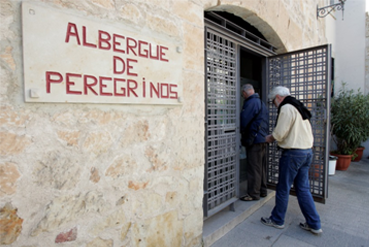
Father César Morán Bardón, one of the most renowned celebrities to come from both Salamanca and the province in the first half of the past century, described his experience along the way as follows: “Once I crossed the bridge, I headed on to the city streets via Hannibal’s Arch, immediately turning left onto Calle de Vera Cruz, and then Calle Libreros, the main thoroughfare of the Roman city; making its way past the Governor’s Palace, located immediately opposite the Palacio Rectoral, and continued past the Clerecía Church, soon exiting via the Puerta del Seminario, where the original Puerta del Sol was located (...) Our route continues from the Puerta del Sol, now behind us, towards the countryside, but which was later to become Calle de Sordolodo, also know as Calle Meléndez, towards the modern Zamora Gateway, that heads back into the city. Passing by the Portuguese railyard, one makes one’s way along the Paseo de Gran Capitán towards the Prado de Panaderos, which joins on to the present day”.
There is no need to praise at this point the wonderful features of the provincial capital, as they are widely known. Instead, we will briefly outline them, otherwise we might never complete our catalogue of the wonders of the former Roman Salmantica. It could be said, for example, that before crossing the Roman Bridge, travellers will come to the Church of the Trinity, popularly known as the Old Arrabal Church, in years past, a refuge for pilgrims. The Roman Bridge itself is one of the most solid in Hispania, in the days when Spain was under Roman rule, with its 27 arches, only half of which are Roman, and almost 360 metres in length. Through Hannibal’s Gate, also going by the name of River Gate and Hercules Gate, came the first settlers, as this is the oldest of all the cities in the province of Salamanca. According to legend, it is called Hannibal’s Gate because the great Carthaginian General walked through it when he took the city. But it’s just a legend. What is true however is that travellers to Salamanca will find much more than simply the end of one stage of the Jacobean route.
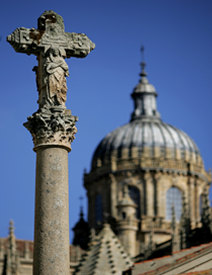
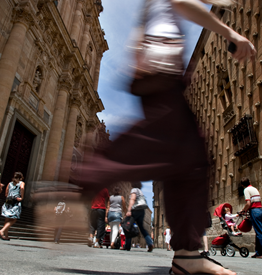
Visitors are strongly recommended to take the time to relax and enjoy everything on offer around them. But if a short list were needed, although clearly insufficient, it would include both Cathedrals, with particular reference to the section that connects them along the breathtaking Ieronimus, the two Universities, the one with the famous frog and the Pontificia, the city’s Romanesque churches, San Marcos, San Martin, San Julian, San Cristóbal, San Juan de Barbalos and Santo Tomas Cantuariense, the Baroque splendours of the multitude of churches, the unparalleled Plaza Mayor, the neoclassic Anaya Palace or from the Modern Movement, the Casa Lis. That is without even mentioning the priceless hidden treasures such as the Huerto de Calixto y Melibea, the Patio de Escuelas, the Patio Chico and the Calle Compañía with the Casa de las Conchas as the crowning touch. In short, the city offers visitors eager to discover the spiritual mysticism days of active rest and utter joy.
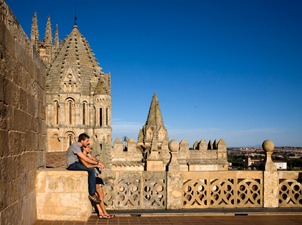
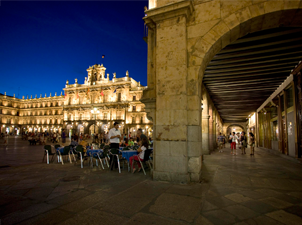
Salmantica was of course home to the fourth mansio that the Romans built along the Vía de la Plata that makes its way through the province